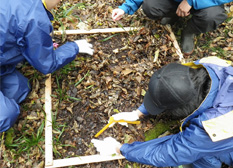Activity Report
Report on Activities from July 2012 to March 2013
2 Daikin Projects Making Good Progress
Project to Restore Japanese Judas Trees and Life-Giving River
Fence Extended to 540 Meters, Height Raised to Deal with Deep Snow
In the autumn of 2011, Daikin employees volunteered in a project to erect a 234-meter-long fence that would allow the forest to grow and that would prevent Sika deer and other wild animals from eating seedlings. The fence was extended by 340 meters in October 2010 and 540 meters of fence have now been completed.
This past winter saw record snowfalls in Shiretoko. To keep the fence above deep snow, it was given a height of 2.5 meters. However, several places were discovered where snow had piled to this height. To prevent the Sika deer from going into the fenced-off area, the fence was made higher where necessary.
 The fence extension was completed. This was the third
time Daikin employees volunteered for this project
The fence extension was completed. This was the third
time Daikin employees volunteered for this project
 The fence was heightened due to snow piling to the top in some
places
The fence was heightened due to snow piling to the top in some
places
Vegetation Survey Determines Effect of Fence
During the summer and autumn of 2012, a survey inside the fenced-off area measured things like the thickness and height of trees and the condition of seedlings that had naturally sprouted. The purpose of the survey was to see if seedlings were growing without being eaten by Sika deer and other wild animals, what effect the deer were having on nature, and how effective the fence was proving.
A comparison of the areas inside and outside the fence showed that for seedlings and small trees at least a year old, only about 70% of those outside the fence discovered in June remained by October. On the other hand, this figure was about 83% for those inside the fence. This shows that seedlings inside the fence are growing comparatively well.
 Vegetation was surveyed at 21 locations inside and outside the
fence
Vegetation was surveyed at 21 locations inside and outside the
fence
Efforts Begun in Earnest to Return Iwaobetsu River to Its Original State
Human beings have altered the flow of the river and built embankments along the lower section of the Iwaobetsu River. Efforts have begun in earnest with the goal of returning the river to its natural state of river edges and meandering patterns and thus making it a suitable habitat for cherry salmon, char salt-water trout, and other fish to breed.
In July 2012, the river was returned to its original natural flow, and stones were placed in an approximately 100-meter stretch of the lower part of the river so that salmon and trout would have a place to breed. A survey in October discovered about 500 cherry salmon and char salt-water trout.
Besides surveying fish species, survey personnel recorded things like river width and depth, flow speed, and size of rocks on the river bottom. However, from late October when the survey finished until late November, there were record rainfalls that dramatically increased water volume and changed the environment of the river. Changes in the Iwaobetsu River caused by these rising water levels will be analyzed and this data will be used to help restore the river.
 Rocks were placed in order to return the river to its original
state
Rocks were placed in order to return the river to its original
state
 The existence of female cherry salmon was confirmed
The existence of female cherry salmon was confirmed
Surveys Conducted on River Birds and Small- and Medium-Sized Mammals
A survey was also conducted on wildlife around the Iwaobetsu River.
In June, bird species in an approximately 2.6-kilometer area along the river were surveyed. Besides black woodpeckers, a protected species, 16 other bird species were confirmed inhabiting the area.
Automatic cameras were also set up to survey small- and medium-sized mammals. In autumn, besides many raccoons, the camera captured many photos of the rarely spotted sable (related to the ferret). This shows that the habitat of the Iwaobetsu River is home to many animals.
 The raccoon is for the most part dormant during
mid-winter but in autumn is extremely active
The raccoon is for the most part dormant during
mid-winter but in autumn is extremely active
Project to Promote Human-Brown Bear Coexistence in Shiretoko
4-Km Fence Erected to Separate Bears and Humans
In 2011, a 750-meter-long area was established in the kelp-drying district of Rausu Town on the east coast of the Shiretoko Peninsula, and here a fence with an electrical charge just strong enough to startle bears was erected to separate the habitats of humans and bears. In autumn 2012, another electric fence was erected in a 4-kilometer-long area starting from the kelp-drying beach and stretching along the left bank of the Rusa River and has been undergoing trial operation. There was an unusually large number of bear incursions into human territory in 2012, but in the fenced area there was not even one recorded case. As well, locals have reported a dramatic reduction in cases of Sika deer droppings in the kelp-drying area.
43 Brown Bears, One of World's Largest Concentrations, Living in Rusha District
There are many brown bears living on the Shiretoko Penissula. And a dense population of brown bears is believed to be inhabiting the Rusha district on the west side of the peninsula. It's important to understand which bears are moving where so that they can be prevented from entering human habitats.
The Shiretoko Peninsula is closed off by snow for half the year, so outdoor surveys must take place during the short time between late spring and early autumn. While bears are hibernating in winter, humans are busy organizing and analyzing the data they have collected during the rest of the year.
One method used for obtaining DNA information uses biopsy darts. Researchers fire a special injection dart at the bears, and the skin and other tissue on the needle is used to take a DNA sample. The recent survey in Shiretoko is the first time that biopsy darts have been used successfully in Japan to collect brown bear samples.
A study of the DNA and hair color samples revealed that there are at least 43 brown bears living in the Rusha district. This is one of the highest concentrations of brown bears in the world.
Researchers plan to use the blood samples to determine the relationship among the brown bears in the Rusha district, verify this with information on brown bears from other areas, and thus determine the bears' pattern of movement.
 Bears and fishermen coexist:
Bears and fishermen coexist: Fishermen and bears have an unspoken agreement to live in harmony

 Analyzing DNA from a skin sample collected using a biopsy dart
Analyzing DNA from a skin sample collected using a biopsy dart
Note: The photos on this website are courtesy of the Shiretoko Nature Foundation.








